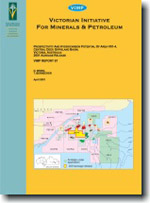VIMP Report 67 - Prospectivity and hydrocarbon potential of area V01-4, Central Deep, Gippsland Basin: 2001 Acreage Release
 |
| |||||
Product description:Download The downloadable version of this report is supplied in PDF format. Executive Summary The offshore Gippsland Basin is a world-class oil- and gas-producing province and Australia’s premier oil-producing region. Its production meets around 40% of the nation’s crude oil and most of the State of Victoria’s gas requirements. The remaining resources (at P50 level) have been assessed at 600 MMB liquids and 5 TCF gas, much of which is likely to occur in deeper stratigraphic units. The basin is located approximately 200 km east of the city of Melbourne and is well serviced by roads and population centres. A network of pipelines brings produced hydrocarbons to the onshore petroleum processing facilities near Longford. A gas pipeline from these facilities was recently commissioned to deliver Gippsland gas to Sydney in New South Wales. Without additional commercially viable discoveries, the offshore Gippsland Basin is facing a decline in crude oil production over the next 10 years. Compared to other giant international hydrocarbon provinces, the Gippsland Basin is under-explored. However, the potential for additional discoveries will ensure continued interest in the region, which will also be maintained by several other factors:
Eight unsuccessful wells were drilled in Area V01-4 between 1965 and 1990, all of which targeted top-Latrobe Group plays. Only Veilfin-1 had oil and gas shows with a production test recovery of 0.3 MMSCF of gas and a small amount of light API condensate over eleven hours of flow from intra-Latrobe sandstones. This VIMP review indicates that a number of fault-blocks and possible structural traps exist in Area V01-4, but despite its proximity to major oil and gas fields, no commercial discoveries were made. In most cases, well failure is related to problematic depth conversion caused by seismic velocity anomalies within the carbonates of the Seaspray Group that provide the regional seal to the top-Latrobe hydrocarbon pools. The anomalies are produced by a complex mid-Miocene channel system that has cut deep into the carbonates and was filled with petrographically diverse sediments. As a consequence, many seemingly valid structures on seismic lines proved to be artefacts and exploration targets were misinterpreted. As far as petroleum systems are concerned, it is interpreted that source, reservoir and seal facies are developed within Area V01-4. Lower coastal plain sediments are recognised source rocks in the basin and these are present in older Latrobe Group sediments. Reservoirs are either represented by fluvial channels or by offshore marine sandbodies. Sealing rocks are provided by a variety of mudstone intervals, both marine and non-marine. The mechanism of fault-seal in the basin, however, is still uncertain and more detailed work is needed before clear predictions can be made whether certain faults act as seals or conduits. Future exploration success in Area V01-4 will inevitably hinge on a sound geological and geophysical understanding of the Seaspray Group, now rendered capable through modern processing. More extensive time-depth conversion based on modern data and technology will help to better define and delineate closures in depth. In order to achieve sufficient velocity data in the gazettal block, new 3D-seismic will be required. Bibliographic reference Wong, D. & Bernecker, T., 2001. Prospectivity and hydrocarbon potential of area V01-4, Central Deep, Gippsland Basin, Victoria, Australia: 2001 Acreage Release. Victorian Initiative for Minerals and Petroleum Report 67. Department of Natural Resources and Environment. | ||||||

